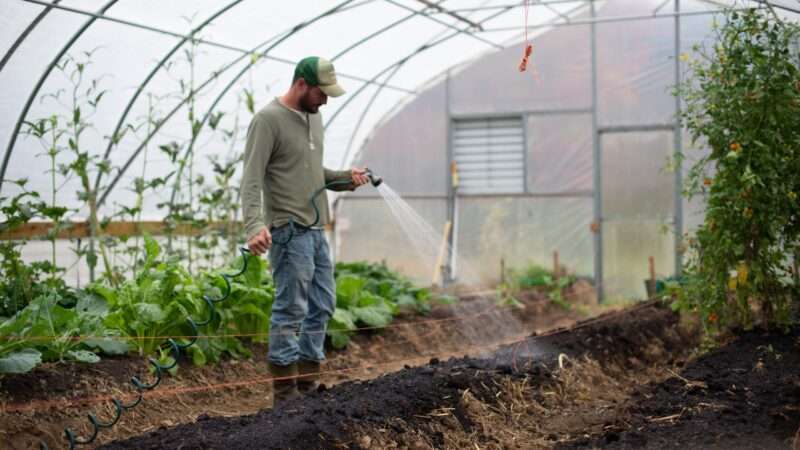
Famine is one of the four horsemen of the apocalypse for good reason; hunger was an unwelcome companion for most of human history. The threat it poses declined in recent decades because of innovations in agriculture and increasing prosperity. But the largely policy-inflicted economic disruptions of the past two years partially reversed progress made towards feeding the world and alleviating poverty. Now, with food prices on the rise, there’s a danger that hunger will follow.
“I want to say this loud and clear right now, that we risk a very low crop in the next harvest,” Svein Tore Holsether, the CEO and president of fertilizer giant Yara International, warned in November. “I’m afraid we’re going to have a food crisis.”
Holsether worried about the rising cost of energy and especially of natural gas, which is needed to make ammonia from which urea, a key fertilizer component, is synthesized.
“Prices for the humble chemical — yes, the stuff in urine — are soaring to levels not seen in over a decade,” The New York Times agreed a month later. “People and industries of all kinds are feeling the shocks.”
A combination of always-unpredictable nature, bad policy, and busted supply chains (also largely from policy decisions) dramatically hiked prices for natural gas and its products. Prices for alternatives to urea are also rising because of demand and parallel political decisions. The U.S. Treasury agreed in December to suspend sanctions on potash from Belarus from which about 20 percent of the world’s supply of the stuff is sourced, but other high trade barriers remain in place for fertilizer and its components. The result is that major inputs for producing the food that we eat are becoming increasingly dear when they can be found at all.
“Among farmers and ranchers, very few topics are being discussed as much as the skyrocketing cost of fertilizer and increasing concerns regarding availability,” the American Farm Bureau reports.
If that’s frightening for American farmers and the people who consume their products, it’s potentially disastrous for the rest of the world.
“High fertilizer prices could exert inflationary pressures on food prices, compounding food security concerns at a time when the COVID-19 pandemic and climate change are making access to food more difficult,” the World Bank notes.
That cautionary tone is a little behind the times, since global food prices were already up by an average of 27.3 percent from a year earlier at the end of November, according to the UN Food and Agriculture Organization’s food price index. Worse, people’s ability to cope with rising food prices has been hit by pandemic-policy-induced setbacks to decades of increasing prosperity.
“In 2021, the average incomes of people in the bottom 40 percent of the global income distribution are 6.7 percent lower than pre-pandemic projections, while those of people in the top 40 percent are down 2.8 percent,” the World Bank noted in October.
A mix of increasing poverty and rising food prices is a dangerous cocktail for a troubled planet.
“Higher farm input costs, expensive shipping and good demand provide for a grim combination,” predicts Holland’s agriculture-oriented Rabobank in its recent report, Outlook 2022: Hell in the Handbasket. “We should see these inflationary pressures upstream move along the supply chain to reach consumers in 2022, with uncertain social consequences.”
Not all of the factors that led us to this unfortunate point were foreseeable or preventable, of course. Nobody could have anticipated that Hurricane Ida would disrupt the production of natural gas “more than any other hurricane over the past ten years” in the words of the U.S. Energy Information Administration. Nor could anybody have known that low winds would hobble Europe’s growing reliance on renewable energy or that drought would kneecap hydropower production in China and elsewhere, throwing those regions back to fossil fuels in competition with other world users.
What was predictable, though, is that nature wouldn’t be predictable. Plans dependent on winds and rains adhering to production schedules were doomed to fail eventually. That they failed after policymakers had already disrupted manufacturing, shipping, and overall economic activity in response to COVID-19 just accelerated an unavoidable reckoning.
“In the fall, soaring electricity demand led the southwestern province of Yunnan, a key phosphate producer, to order drastic production cuts by energy-hungry industries, including fertilizer,” The New York Times reported.
“Major fertilizer producers Yara International ASA and CF Industries Holdings Inc. said soaring energy costs are forcing them to halt some output of nutrients crucial for growing crops,” BloombergQuint noted of the effects of Europe’s energy costs.
Curbs on fertilizer exports from China and Russia add to the problem, as the governments of those countries reserve limited supplies for their internal markets. But the U.S. suffers self-inflicted wounds from trade barriers on foreign products.
“Mosaic has almost single-handedly erected an insurmountable tariff barrier to keep its top competitors in Morocco and Russia out of the U.S. phosphate market,” the National Corn Growers Association objected in a December letter to fertilizer giant Mosaic company over its cultivation of policy-making friends. “Only 15% of phosphorous imports now come into the U.S. without tariffs.”
The Biden administration also discourages the production of fossil fuels. It does so with the idea of encouraging a national move to renewable energy, but one (presumably) unforeseen consequence is to tighten the supply of materials required for making fertilizer needed to grow food.
“Heavy-handed interference in market economies tends to produce the same pathologies we see in socialist economies, including shortages and inflation,” British economist Philip Pilkington commented earlier this year.
That interference is tempting for government officials who insist on seeing the world as something they can fine-tune according to their policy preferences. Inevitably, they’re proven wrong, though usually not in disastrous ways. This time though, economic meddling looks to be amplifying nature’s unpredictability to usher in a hungry new year.
The post Food Costs Likely To Rise as Farmers' Expenses Shoot Up appeared first on Reason.com.
from Latest – Reason.com https://ift.tt/32WxOYS
via IFTTT